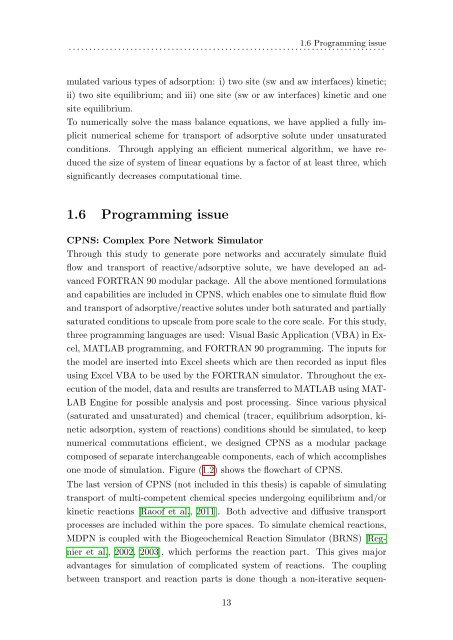download pdf version of PhD book - Universiteit Utrecht
download pdf version of PhD book - Universiteit Utrecht
download pdf version of PhD book - Universiteit Utrecht
Create successful ePaper yourself
Turn your PDF publications into a flip-book with our unique Google optimized e-Paper software.
1.6 Programming issue<br />
. . . . . . . . . . . . . . . . . . . . . . . . . . . . . . . . . . . . . . . . . . . . . . . . . . . . . . . . . . . . . . . . . . . . . . . . . . . . .<br />
mulated various types <strong>of</strong> adsorption: i) two site (sw and aw interfaces) kinetic;<br />
ii) two site equilibrium; and iii) one site (sw or aw interfaces) kinetic and one<br />
site equilibrium.<br />
To numerically solve the mass balance equations, we have applied a fully implicit<br />
numerical scheme for transport <strong>of</strong> adsorptive solute under unsaturated<br />
conditions. Through applying an efficient numerical algorithm, we have reduced<br />
the size <strong>of</strong> system <strong>of</strong> linear equations by a factor <strong>of</strong> at least three, which<br />
significantly decreases computational time.<br />
1.6 Programming issue<br />
CPNS: Complex Pore Network Simulator<br />
Through this study to generate pore networks and accurately simulate fluid<br />
flow and transport <strong>of</strong> reactive/adsorptive solute, we have developed an advanced<br />
FORTRAN 90 modular package. All the above mentioned formulations<br />
and capabilities are included in CPNS, which enables one to simulate fluid flow<br />
and transport <strong>of</strong> adsorptive/reactive solutes under both saturated and partially<br />
saturated conditions to upscale from pore scale to the core scale. For this study,<br />
three programming languages are used: Visual Basic Application (VBA) in Excel,<br />
MATLAB programming, and FORTRAN 90 programming. The inputs for<br />
the model are inserted into Excel sheets which are then recorded as input files<br />
using Excel VBA to be used by the FORTRAN simulator. Throughout the execution<br />
<strong>of</strong> the model, data and results are transferred to MATLAB using MAT-<br />
LAB Engine for possible analysis and post processing. Since various physical<br />
(saturated and unsaturated) and chemical (tracer, equilibrium adsorption, kinetic<br />
adsorption, system <strong>of</strong> reactions) conditions should be simulated, to keep<br />
numerical commutations efficient, we designed CPNS as a modular package<br />
composed <strong>of</strong> separate interchangeable components, each <strong>of</strong> which accomplishes<br />
one mode <strong>of</strong> simulation. Figure (1.2) shows the flowchart <strong>of</strong> CPNS.<br />
The last <strong>version</strong> <strong>of</strong> CPNS (not included in this thesis) is capable <strong>of</strong> simulating<br />
transport <strong>of</strong> multi-competent chemical species undergoing equilibrium and/or<br />
kinetic reactions [Rao<strong>of</strong> et al., 2011]. Both advective and diffusive transport<br />
processes are included within the pore spaces. To simulate chemical reactions,<br />
MDPN is coupled with the Biogeochemical Reaction Simulator (BRNS) [Regnier<br />
et al., 2002, 2003], which performs the reaction part. This gives major<br />
advantages for simulation <strong>of</strong> complicated system <strong>of</strong> reactions. The coupling<br />
between transport and reaction parts is done though a non-iterative sequen-<br />
13

















